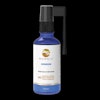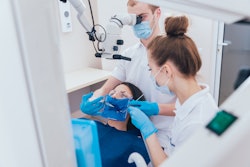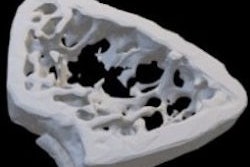
A nanoparticle-containing solution used to treat anemia significantly reduced the buildup of dental plaque and suppressed tooth decay in a study published on October 25 in Nano Letters. It is the first human study to show the nanoparticle's therapeutic potential for caries, according to the authors.
When the ferumoxytol iron oxide nanoparticles (FerIONP), a formulation approved by the U.S. Food and Drug Administration (FDA) for the treatment of anemia, and hydrogen peroxide (H2O2) were used in a human disease model, the combination showed potent antimicrobial properties against one of most common bacterial pathogens in biofilms, Streptococcus mutans.
"We present the first human study demonstrating the potential therapeutic application of catalytic iron oxide nanoparticles (nanozymes) as a targeted nanomedicine against an oral infectious disease," wrote the authors, led by Dr. Hyun (Michel) Koo, PhD, a professor at the University of Pennsylvania School of Dental Medicine.
Current antimicrobials and clinical approaches have limited effectiveness against the biofilms that cause caries. This has led researchers to look for therapies, such as the ferumoxytol and hydrogen peroxide treatment, to target oral pathogens without damaging normal tissue. Previous research conducted by Koo and colleagues showed this treatment could prevent biofilm accumulation and tooth decay in experimental and animal models.
To further investigate the effect of the ferumoxytol-hydrogen peroxide treatment on caries, the authors had 15 participants wear removable, denturelike devices with real tooth enamel attached. The participants were then divided into three groups. One group applied ferumoxytol twice per day, followed by hydrogen peroxide in a mouth rinse; the nanoparticles act as enzymes, activating the hydrogen peroxide. The second group applied a solution with inactive ferumoxytol, and the third group applied only water.
The participants also applied a sugar solution to the device four times per day. They were instructed to rinse the device twice a day, but not to brush it.
After 14 days, Koo and colleagues analyzed the biofilms that had accumulated on the enamel specimens. The combination of ferumoxytol and hydrogen peroxide significantly reduced the growth of S. mutans-containing biofilms and could kill the bacteria with high specificity, they found.
Additionally, the ferumoxytol-hydrogen peroxide treatment did not affect other bacteria found in the mouth. No reported complications or adverse events were associated with the therapy, they wrote.
Drawbacks of the study included its short clinical duration and the limited characterization of the microbial composition, the authors noted.
However, the findings support the treatment's clinical potential, which is important given the insufficiency of current caries prevention strategies for vulnerable populations, they wrote.
"Biofilms harboring S. mutans cells were effectively inhibited after FerIONP/H2O2 treatment, suggesting the targeting specificity against this organism," Koo and colleagues concluded.




















